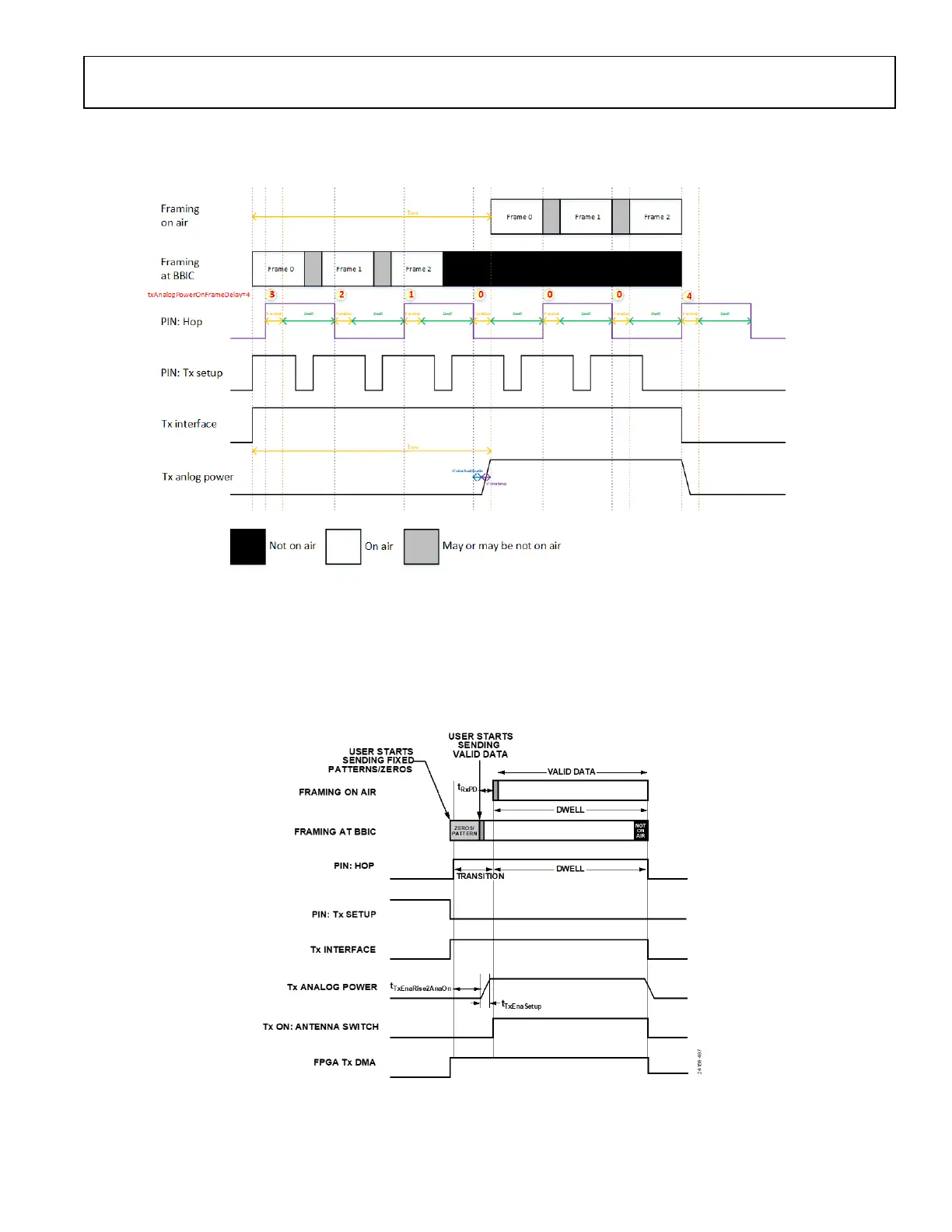Preliminary Technical Data UG-1828
Rev. PrB | Page 119 of 277
LP
ADC
LP
ADC
16 BITS
LPF OUTPUT
LPF OUTPUT
LPADC
HPADC
2p2G
1p47G
1p1G
16 BITS
HP
ADC
HP
ADC
ADC_H
ADC_L
ADC CLK
MUX
WB RX MUX
ADC_M
2211.84M
1105.92M
1474.56M
5 BITS
5 BITS
DEC/8
DEC/12
DEC/6
DEC/3 DEC/8
DEC/16
DEC/32
DEC/2
DEC/4
184.32MHz
61.44MHz
30.72MHz
46.08MHz
DEC/2
23.04MHz
46.08MHz
DEC/40 DEC/40
DEC/24
DEC/8
DEC/6
DEC/4
1152kHz
15.36MHz
7.68MHz
3.84MHz
192kHz
144kHz
48kHz
288kHz
24kHz
1.92MHz
61.44MHz
LTE20M
LTE40M_1
LTE15M
LTE10M
LTE5M
LTE3M
LTE1.4M
LTE40M_2
NB RX MUX
DMR48K
TETRA_1
TETRA_192K
DMR_R0
DMR_R1
P25_1_R1
FM_R1
TETRA_2
DEC/4
24159-098
Figure 125. Decimation Schemes in Receiver Data Chain to Support Various Standards
As shown in Figure 125, in NB and WB mode, 3 different ADC output sample rates are first decimated to a fix rate of 184.32 MHz. Then,
it is further converted to 2 different rates, one is 61.44 for WB mode only and the other is 46.08 MHz for both NB and WB modes. All
LTE standard modes are considered WB and the desired sample rate is further generated from both 61.44 MHz and 46.08 MHz through
a decimation rate of 2 to 32. DMR, FM, P25 and Tetra are NB modes and the desired sample rate is further generated from 46.08 MHz
with a decimation rate of 160-1920.
For each decimator show in Figure 125, it could consist a combination of lower rate decimation filters. For example, DEC/40 could be
implemented as a cascade of DEC/10 and 2 DEC/2 decimators. In addition, the different decimation rates are achieved by strategically
enabling and disabling some lower rate decimators. For example, in WB mode, with an initial sample rate of 61.44 MHz, if all lower rate
decimators are used, it can achieve a decimation rate of 32. If two of the DEC/2 are disabled, a decimation rate of 8 can be achieved. All
the decimation filters are carefully designed to satisfy the system performance requirements.
With arbitrary sample rate, the user could get an almost continuous range of sample rates from 24 kHz to 61.44 MHz except for some
“dead zones” due to internal clocking constraints. This is achieved through adjusting the internal CLK PLL frequency as well as a flexible
arrangement of decimators.
DC OFFSET
The ADRV9001 receiver supports both IF down conversion and ZIF down conversion. The source of the DC offset is mainly from the
receiver LO leakage caused by the finite isolation between the LO and RF ports of a mixer, which is typical for silicon-based ICs. It could
generate a high DC component at the center of the desired signal band especially for ZIF operation. Through the datapath, the induced
dc offset is amplified and could reduce the ADC dynamic range significantly. In addition to receiver LO leakage, the device mismatch in
LPF and ADC also contributes to the DC offset problem. Without properly correcting the DC offset, it could cause a negative impact on
the system performance.
In ADRV9001, a two-step approach is taken to estimate and correct the DC offset. The first step comprises of an DC estimation step in
the digital domain and a correction procedure in the analog domain. The second step is an all-digital DC offset estimation and correction
technique that estimates and corrects for any residual DC offset after the first step.
QEC
In an ideal analog mixer, the in-phase (I) and quadrature-phase (Q) sinusoidal signals are orthogonal. In addition, the I and Q path of
LPF and ADC should have identical frequency responses. However, in reality, IQ imbalance always exists in the mixer, LPF and ADC,
resulting in quadrature errors. Without properly handling it, it seriously degrades the reception performance. For IF reception, the
respective image mixes partially onto the desired signal during the IF down conversion. In direct conversion reception, IQ-imbalance
leads to a distortion of the IQ-signals themselves within the respective desired baseband channel.
In general, quadrature error can be classified as frequency independent error (FIE) and frequency dependent error (FDE). FIE is mainly
caused by the mixer I/Q sinusoid mismatch in both gain and phase, while FDE is mainly caused by the inconsistent filter responses.

